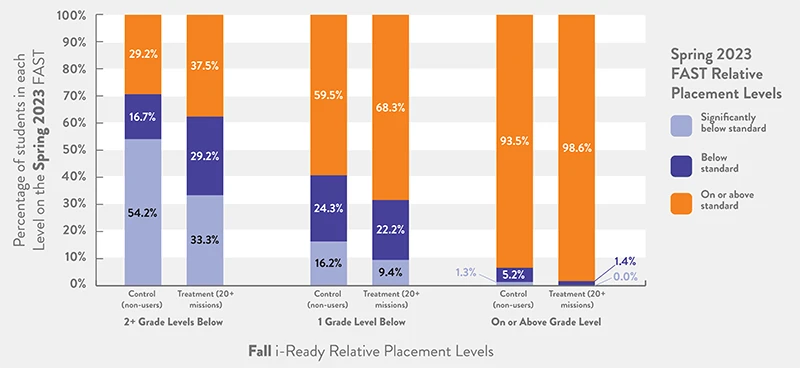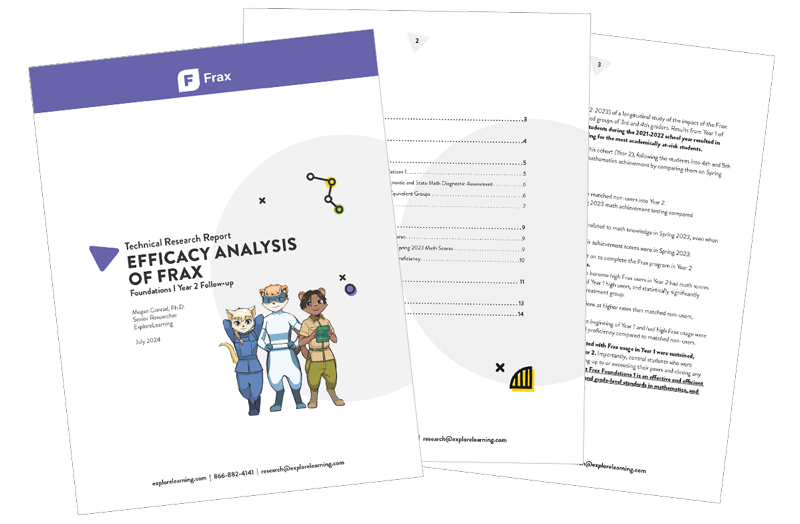
Ongoing research is vital. That’s why our researchers examined the impact of the findings from Year 2 of a longitudinal study of the impact of Frax on the math achievement of matched groups of 3rd and 4th graders.
Research shows significant growth in math achievement
ExploreLearning Frax, an adaptive, game-based fractions program, is designed to support all learners in building a solid conceptual understanding of fractions. Students complete game-based missions (grouped by Sector 1 and Sector 2) that provide students with the right level of support they need, either as a first introduction to fractions or as a remediation tool to fix common misconceptions and challenges.
ExploreLearning has been partnering with a large, suburban Florida school district since 2021 to measure the impact of using Frax on students’ fractions knowledge and overall math achievement. The first year of the study compared 2,520 grade 3 and 4 students who used Frax during the 2021-2022 school year to a statistically matched sample of non-users. Researchers used the change in students’ i-Ready Diagnostic math assessments from fall to spring to measure the impact of Frax usage on student achievement.
Year 1 findings
Results from Year 1 of the study found that usage of Frax by 3rd and 4th-grade students during the 2021-2022 school year resulted in statistically significant gains in math achievement, including for the most academically at-risk students.
Sustained math achievement gains in Year 2
The current study found that the achievement gains associated with Frax usage in year one were sustained, as measured via performance on a standards achievement test in Year 2. Importantly, students in grades 4 and 5 who used Frax in Year 2 also showed achievement gains, fully catching up to or exceeding their peers and closing any achievement gaps observed in Year 1.
Continued impact analysis
The current report analyzes the second year for this cohort, following the students into 4th and 5th grade and examining the continued impact of Frax usage on mathematics achievement by comparing their Spring 2023 scores on their state math assessment.
This research was designed to meet the Every Student Succeeds Act (ESSA) Tier 2 (Moderate) rating on the ESSA guidelines for evidence-based interventions. The study used quasi-experimental matching methods to create baseline equivalency between treatment and control groups along major confounding factors.
The analyses included data from all of the first-year students that researchers could follow into Year 2, which was 2,109 matched pairs of 4th and 5th-grade students, half of whom used Frax in Year 1. Because some of the students in the original control group also used Frax in the 2022-2023 school year, researchers could compare student growth with different exposure points. Dependent variables used in the current study include scores from both i-Ready Diagnostic math assessments and a newly implemented state-wide diagnostic math assessment administered for the first time in Spring 2023.
Key findings in Year 2
What were the research outcomes? Key findings include:
- Students who used Frax in Year 1 continued to outperform matched non-users into Year 2.
- Usage of Frax in either Year 1 or Year 2 was significantly correlated to both fractions knowledge and overall math achievement in Spring 2023. The more students used Frax, the higher their achievement scores were in Spring 2023.
- Students in Grades 4 and 5 who were in the non-usage group in Year 1 but completed the Frax program in Year 2 were able to catch up to or surpass their matched peers fully.
- Frax users continued to meet grade-level proficiency expectations at higher rates than matched non-users, especially for the most academically at-risk students.
Building on knowledge from the year one analysis of a large sample of over 5,000 case-control matched 3rd and 4th-grade students, the results spoke for themselves. Evidence showed that less than 13 hours of classroom usage of Frax led to statistically significant improvements in academic growth between fall and spring administrations of a diagnostic math test.
The benefits of the Frax program observed in Year 1 were maintained in Year 2, with those matched students who used Frax in Year 1 continuing to show significantly higher academic performance on standardized mathematics achievement tests compared to baseline matched students who did not use Frax over a year after program usage.
Frax’s long-term impact on fractions and math success
Frax usage led to sustained improvement in math skills for even the most academically at-risk students in the study. Over half (54%) of students who placed two or more grade levels below standards in Fall 2021 and did not use Frax remained significantly below standards nearly two years later in Spring 2023.
However, only one-third (33%) of the students who were identical to them but had high Frax completion remained in this category in Spring 2023. High Frax users were significantly more likely to meet or exceed grade-level standards compared to their matched non-users.

This evidence is clear. Frax is an effective and efficient intervention tool that has a lasting impact on students’ mastery of fractions and grade-level standards in mathematics.
Using Frax to close math achievement gaps
Frax can even be used well into 5th grade to help close math achievement gaps. This study shows that providing additional practice in the foundational knowledge of fractions can help correct potential misconceptions about fractions and ensure students are better prepared for grade-level fractions content in their classrooms. The outcome? Improvement on end-of-year summative assessments testing fractions standards performance.

The Frax approach teaches students that fractions are numbers. Students learn that fractions have a magnitude (size) and expand the number system beyond whole numbers in useful ways. Are you ready to bring a whole new level of understanding to your math students? Start your free trial today.
Take a Trial
What about the research? If you’re craving more details about this report, it’s ready for you!
